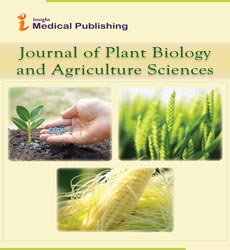The Toxicity and the Ultrastructural Modifications Induced by Indium in the Brain and in the Placenta Tissues of Pregnant Rat
Abstract
Indium is a chemical element (with symbol In), being the 61st element in abundance in the earth's crust with a proportion of 0.24ppm per unit of weight. It has several physicochemical properties that allow it to be used in different fields such as: medicine and industry, which places the human being in direct and indirect contact with this metal. In can be source of some toxicity, noting that its toxicity depends on the absorption route and the compounds studied, embryotoxic or embryologic and teratogenic effects with different compounds (Pilliére, 2003). The aim of this work was to determine the impact of indium in the brain and placenta tissues of a pregnant rats using transmission electron microscopy (TEM). The ultrastructural study of brain tissue (neuron, glial cells) and placenta (maternal and fetal face) of treated rats with indium sulfate showed the presence of dense electron deposits in the lysosomes, altered mitochondria and dilated endoplasmic reticulum, on the other hand, no deposit in the control tissue. It is concluded that indium is a toxic element that can cause some intracellular damages.
We used in this study 24 pregnant female Wistar rats, weighing around 250 g. These rats were divided into two groups (M1, M2), they were kept for 15 days on a 12 h dark/12 h light cycle in the department of Experimental Medicine of Faculty of Medicine of Tunis in order to be acclimated. The rats were fed ad libitum and have no restriction to water. Each cage contained two females, and one male to make the coupling. A vaginal smear test was done to check the pregnancy gestation. Beginning with the 16th day of gestation, the female rats underwent daily injections as follows: The first group (M1) of 12 rats received 4 intraperitoneal injections of 1 mL containing 1 mg of soluble solution of indium sulfate [In2 (SO4) 3] (Merk, France), in order to accumulate a total dose of 16 mg/kg of body weight. Received date: 14/11/2018 Accepted date: 19/11/2018 Published date: 26/11/2018 *For Correspondence Marwa Mhamdi, Department of Physiology, Faculty of Medicine of Tunis (University of Tunis El Manar),15 Rue Jebel Lakhdhar, 1007 Baab Saadoun, Rabta, Tunis, Tunisia. Tel: 0021625581366 E-mail: marmar.mhamdi@yahoo.fr Keywords: Indium, Brain, Placenta, Toxicity ABSTRACT Indium is a chemical element (with symbol In), being the 61st element in abundance in the earth's crust with a proportion of 0.24 ppm per unit of weight. It has several physicochemical properties that allow it to be used in different fields such as: medicine and industry, which places the human being in direct and indirect contact with this metal. In can be source of some toxicity, noting that its toxicity depends on the absorption route and the compounds studied, embryotoxic or embryologic and teratogenic effects with different compounds (Pilliére, 2003). The aim of this work was to determine the impact of indium in the brain and placenta tissues of a pregnant rats using transmission electron microscopy (TEM). The ultrastructural study of brain tissue (neuron, glial cells) and placenta (maternal and fetal face) of treated rats with indium sulfate showed the presence of dense electron deposits in the lysosomes, altered mitochondria and dilated endoplasmic reticulum, on the other hand, no deposit in the control tissue. It is concluded that indium is a toxic element that can cause some intracellular damages. 2 e-ISSN:2322-0066 Research & Reviews: Research Journal of Biology RRJOB | Volume 6 | Issue 4 | November, 2018.
The second group (M2) of 12 control rats received physiological serum in the same experimental conditions. Twenty-four hours after the last injection, all rats were anesthetized, the two organs (brain and placenta) were removed, and all rats were killed by rapid decapitation. The rates used in this study were maintained and treated according to internal institutional rules, based on the principles of ethics in animal experimentation. Method of Sampling The cortical region of the brain and the placenta were cut into fragments of 1 mm3. These fragments were immediately immersed in a 3% glutaraldehyde solution in sodium cacodylate buffer for 24 hours at 4°C. After rinsing in the same buffer, the fragments were post-fixed in 1% osmium tetroxide for 17 hours at an ambient temperature of 25°C. All fragments were dehydrated in ethanol baths of increasing concentration, and in two baths of propylene oxide, then embedded in Resin Epoxy (Epon) and incubated for 48 h at 45°C and for 24 h at 60°C. Semithin sections of 100 to 150 nm thicknesses were obtained. Tissues areas selected on semithin sections were then cut to obtain ultrathin sections that were collected on 300 mesh copper grids. These cuts were contrasted with uranyl acetate and lead citrate, and examined with the transmission electron microscopy. Monitoring Methods: Transmission Electron Microscopy (TEM) TEM based on the emission in a column or a satisfactory vacuum of electron beams which pass through only an object of very small thickness. The resulting image will be recorded on a sensitive plate.
Open Access Journals
- Aquaculture & Veterinary Science
- Chemistry & Chemical Sciences
- Clinical Sciences
- Engineering
- General Science
- Genetics & Molecular Biology
- Health Care & Nursing
- Immunology & Microbiology
- Materials Science
- Mathematics & Physics
- Medical Sciences
- Neurology & Psychiatry
- Oncology & Cancer Science
- Pharmaceutical Sciences
